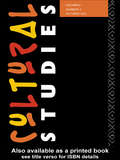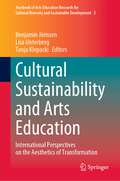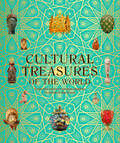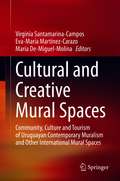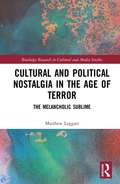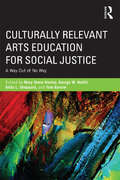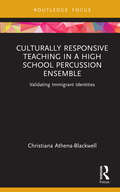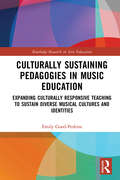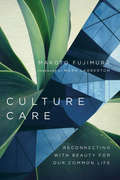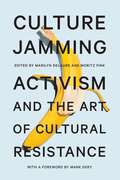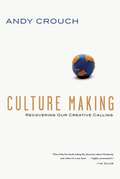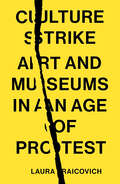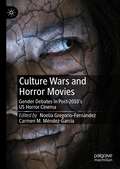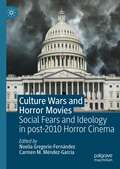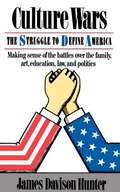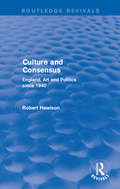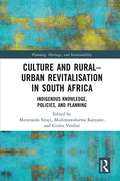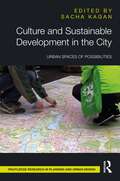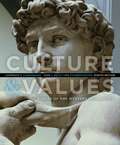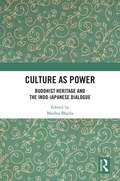- Table View
- List View
Cultural Studies: Volume 9 Issue 3
by Lawrence Grossberg Janice RadwayFirst published in 1995. Routledge is an imprint of Taylor & Francis, an informa company.
Cultural Sustainability and Arts Education: International Perspectives on the Aesthetics of Transformation (Yearbook of Arts Education Research for Cultural Diversity and Sustainable Development #2)
by Benjamin Jörissen Lisa Unterberg Tanja KlepackiThis book is based on the topics, questions and results of the international conference "Aesthetics of Transformation - Arts Education Research and the Challenge of Cultural Sustainability". It aims to foster and sharpen the understanding of the potential role of arts education and arts education research for cultural sustainability. In an ever more complex and interconnected world, culture is a valuable resource for sustainable development. Based on the thesis that the change towards sustainability has to be a change that starts with cultural practices of perception and knowledge, this book makes an important contribution to the broad discourse on cultural sustainability, which has begun to emerge in recent years.In this context, the volume first deals with Intangible Cultural Heritage and how aesthetic practices and certain forms of art are changing through cultural transformation processes. Subsequently, it focuses on issues such as arts and cultural education in times of neoliberalism, (post-)migration and post-coloniality as well as on arts and cultural education under conditions of digital transformation. These theoretical and empirical contributions are complemented by insights into field trips to institutions and exemplary places of practice, showing different representations of educational art practices, cultural heritage, and cultural sustainability. Against this background the book finally offers responses and commentaries that can form the starting point for a far reaching interactive dialogical process on the utmost importance of cultural, aesthetic and arts education as part of a global endeavor for sustainable development.
Cultural Sustainability: Perspectives from the Humanities and Social Sciences (Routledge Environmental Humanities)
by Gabriele Rippl Torsten MeireisIf the political and social benchmarks of sustainability and sustainable development are to be met, ignoring the role of the humanities and social, cultural and ethical values is highly problematic. People’s worldviews, beliefs and principles have an immediate impact on how they act and should be studied as cultural dimensions of sustainability. Collating contributions from internationally renowned theoreticians of culture and leading researchers working in the humanities and social sciences, this volume presents an in-depth, interdisciplinary discussion of the concept of cultural sustainability and the public visibility of such research. Beginning with a discussion of the concept of cultural sustainability, it goes on to explore its interaction with philosophy, theology, sociology, economics, arts and literature. In doing so, the book develops a much needed concept of ‘culture’ that can be adapted to various disciplines and applied to research on sustainability. Addressing an important gap in sustainability research, this book will be of great interest to academics and students of sustainability and sustainable development, as well as those studying sustainability within the humanities and social sciences, such as cultural studies, ethics, theology, sociology, literature and history.
Cultural Treasures of the World: From the Relics of Ancient Empires to Modern-Day Icons (DK Wonders of the World)
by DKTake a guided tour through history and discover the most precious, iconic, and celebrated objects ever created.Revered, admired, and protected - every country and culture has certain artifacts that are prized above all others. Cultural Treasures of the World brings together more than 200 of these objects, exploring the fascinating and unique stories behind each of them.From the Bust of Nefertiti to the Benin Bronzes, and the Altamira cave paintings to Van Gogh's Sunflowers, these artifacts and artworks are revered for their beauty, artistry, or historical significance - and often all three at once. Discover how and why they were created, unravel the hidden meanings and symbolism they contain, and learn about the cultural legacy they have left behind.So what are you waiting for? Dive into this awe-inspiring history of art book to explore: - An immersive &“visual tour&” approach, combining stunning photography with accessible text and annotation- Feature boxes on cultural influences, symbolism, and technique offer additional context- Covers a wide range of regions, periods, and media – including sculpture, painting, jewelry, tapestry, rock art, documents, sacred objects, and moreA treasure trove of human creativity that offers a fresh and unforgettable new perspective on civilizations and societies, Cultural Treasures of the World is the perfect gift for gallery- and museum-lovers, and armchair travelers everywhere. Doubling up as a great coffee table book, Cultural Treasures of the World combines stunning photography with detailed annotation to highlight key elements of technique, artistry, and symbolism, making this museum in a book perfect for anyone with an interest in art, history and culture alike.
Cultural and Creative Mural Spaces: Community, Culture and Tourism of Uruguayan Contemporary Muralism and Other International Mural Spaces
by Virginia Santamarina-Campos Eva-María Martínez-Carazo María De-Miguel-MolinaThis book puts into context the evolution of mural art in recent years, particularly the case of the contemporary muralism in Uruguay. While the focus of this volume, revolves around Uruguay, the editors demonstrate that circumstances found in Uruguay are also reflected widely in a large number of cases worldwide. Mural art has evolved from an elite audience to a more popular objective. At the same time, it does not lose the necessity of high value artists that, not only technically but also conceptually, will be able to connect to the audience and provide a sense of identity and necessity of preservation of this art.This leads to a down-top approach, where different actors take part in the process, from the conceptualization to the conservation. Moreover, mural art has been studied as a driver of local economic development, attracting visitors and tourists can access these open-air museums easily. This book is of interest to students and researchers working in fine art, heritage and museum studies.
Cultural and Political Nostalgia in the Age of Terror: The Melancholic Sublime (Routledge Research in Cultural and Media Studies)
by Matthew LeggattThis book re-examines the role of the sublime across a range of disparate cultural texts, from architecture and art, to literature, digital technology, and film, detailing a worrying trend towards nostalgia and arguing that, although the sublime has the potential to be the most powerful uniting aesthetic force, it currently spreads fear, violence, and retrospection. In exploring contemporary culture, this book touches on the role of architecture to provoke feelings of sublimity, the role of art in the aftermath of destructive events, literature’s establishment of the historical moment as a point of sublime transformation and change, and the place of nostalgia and the returning of past practices in digital culture from gaming to popular cinema.
Culturally Relevant Arts Education for Social Justice: A Way Out of No Way
by George W. Noblit Tom Barone Mary Stone Hanley Gilda L. SheppardA groundswell of interest has led to significant advances in understanding and using Culturally Responsive Arts Education to promote social justice and education. This landmark volume provides a theoretical orientation to these endeavors. Examining a range of efforts across different forms of art, various educational settings, and diverse contexts, it foregrounds the assets of imagination, creativity, resilience, critique and cultural knowledge, working against prevailing understandings of marginalized groups as having deficits of knowledge, skills, or culture. Emphasizing the arts as a way to make something possible, it explores and illustrates the elements of social justice arts education as "a way out of no way" imposed by dominance and ideology. A set of powerful demonstrations shows how this work looks in action. Introductions to the book as a whole and to each section focus on how to use the chapters pedagogically. The conclusion pulls back the chapters into theoretical and pedagogical context and suggests what needs done to be done practically, empirically, and theoretically, for the field to continue to develop.
Culturally Responsive Teaching in a High School Percussion Ensemble: Validating Immigrant Identities (Routledge Focus on Music Education: Culturally Responsive Teaching)
by Christiana Athena-BlackwellCulturally Responsive Teaching in a High School Percussion Ensemble: Validating Immigrant Identities addresses themes of immigration, identity, and culturally responsive teaching in music education using a deep case study of Brazilian samba music in the context of a high school percussion ensemble.Through an in-depth ethnographic study of the World Percussion Ensemble at Somerville High School, Massachusetts, and how it was renovated by a progressive music program director, the author demonstrates how a program can respond to the cultures and needs of immigrant students by creating a unique intercultural community within the classroom. The book recognizes key components in the process of immigrant social integration: (1) music education can help facilitate immigrant students’ adjustment to a new culture as they negotiate a hybrid identity. (2) The inclusive nature of samba percussion music encourages communication, cooperation, and empathy, helping students to build life skills. (3) By blending rhythms from their countries of origin with a pop song of choice for their final composition, the students create their own interculture.Deriving from culturally responsive music teaching practices, this study will inspire music teachers and music education researchers to transfer some of the methods to center students’ languages, identities, and cultural references in their curricula.
Culturally Sustaining Pedagogies in Music Education: Expanding Culturally Responsive Teaching to Sustain Diverse Musical Cultures and Identities (Routledge Research in Arts Education)
by Emily Good-PerkinsThis volume problematizes the historic dominance of Western classical music education and posits culturally sustaining pedagogy (CSP) as a framework through which music curricula can better serve increasingly diverse student populations. By detailing a qualitative study conducted in an urban high school in the United States, the volume illustrates how traditional approaches to music education can inhibit student engagement and learning. Moving beyond culturally responsive teaching, the volume goes on to demonstrate how enhancing teachers’ understanding of alternative musical epistemologies can support them in embracing CSP in the music classroom. This new theoretical and pedagogical framework reconceptualizes current practices to better sustain the musical cultures of the minoritized. This text will benefit researchers, academics, and educators with an interest in music education, multicultural education, and urban education more broadly. Those specifically interested in ethnomusicology and classroom practice will also benefit from this book.
Culture Care: Reconnecting with Beauty for Our Common Life
by Makoto Fujimura15th Annual Outreach Magazine Resource of the Year - Culture Christianity Today's 2018 Book of the Year Award of Merit - Culture and the Arts "Culture is not a territory to be won or lost but a resource we are called to steward with care. Culture is a garden to be cultivated." Many bemoan the decay of culture. But we all have a responsibility to care for culture, to nurture it in ways that help people thrive. In Culture Care artist Makoto Fujimura issues a call to cultural stewardship, in which we become generative and feed our culture's soul with beauty, creativity, and generosity. We serve others as cultural custodians of the future. This is a book for artists, but artists come in many forms. Anyone with a calling to create—from visual artists, musicians, writers, and actors to entrepreneurs, pastors, and business professionals—will resonate with its message. This book is for anyone with a desire or an artistic gift to reach across boundaries with understanding, reconciliation, and healing. It is a book for anyone with a passion for the arts, for supporters of the arts, and for "creative catalysts" who understand how much the culture we all share affects human thriving today and shapes the generations to come. Culture Care includes a study guide for individual reflection or group discussion.
Culture Jamming: Activism and the Art of Cultural Resistance
by Moritz Fink Marilyn DeLaureA collaboration of political activism and participatory culture seeking to upend consumer capitalism, including interviews with The Yes Men, The Guerrilla Girls, among others. Coined in the 1980s, “culture jamming” refers to an array of tactics deployed by activists to critique, subvert, and otherwise “jam” the workings of consumer culture. Ranging from media hoaxes and advertising parodies to flash mobs and street art, these actions seek to interrupt the flow of dominant, capitalistic messages that permeate our daily lives. Employed by Occupy Wall Street protesters and the Russian feminist punk band Pussy Riot alike, culture jamming scrambles the signal, injects the unexpected, and spurs audiences to think critically and challenge the status quo. The essays, interviews, and creative work assembled in this unique volume explore the shifting contours of culture jamming by plumbing its history, mapping its transformations, testing its force, and assessing its efficacy. Revealing how culture jamming is at once playful and politically transgressive, this accessible collection explores the degree to which culture jamming has fulfilled its revolutionary aims. Featuring original essays from prominent media scholars discussing Banksy and Shepard Fairey, foundational texts such as Mark Dery’s culture jamming manifesto, and artwork by and interviews with noteworthy culture jammers including the Guerrilla Girls, The Yes Men, and Reverend Billy, Culture Jamming makes a crucial contribution to our understanding of creative resistance and participatory culture.
Culture Making: Recovering Our Creative Calling
by Andy CrouchIt is not enough to condemn culture. Nor is it sufficient merely to critique culture or to copy culture. Most of the time, we just consume culture. But the only way to change culture is to create culture. In his new book Andy Crouch unleashes a stirring manifesto calling Christians to be culture makers. For too long Christians have had an insufficient view of culture and have waged misguided "culture wars." But we must reclaim the cultural mandate to be the creative cultivators that God designed us to be. A model of his premise, this landmark book is sure to be a rallying cry for a new generation of culturally creative Christians. Discover your calling to become a culture maker! Endorsements "Culture Making is a book that's been needed for decades, but it arrives at just the right moment. People of faith now poised to use their influence have much to contribute to the common good as creators and advocates, not just as critics and judges. But that requires careful thought and clear insight, both of which are abundantly found in this profound and practical book." D. Michael Lindsay, author of Faith in the Halls of Power and assistant professor of sociology, Rice University
Culture Strike: Art and Museums in an Age of Protest
by Laura RaicovichA leading activist museum director explains why museums are at the center of a political stormIn an age of protest, cultural institutions have come under fire. Protestors have mobilized against sources of museum funding, as happened at the Metropolitan Museum, and against board appointments, forcing tear gas manufacturer Warren Kanders to resign at the Whitney. That is to say nothing of demonstrations against exhibitions and artworks. Protests have roiled institutions across the world, from the Abu Dhabi Guggenheim to the Akron Art Museum. A popular expectation has grown that galleries and museums should work for social change. As Director of the Queens Museum, Laura Raicovich helped turn that New York muni- cipal institution into a public commons for art and activism, organizing high-powered exhibitions that doubled as political protests. Then in January 2018, she resigned, after a dispute with the Queens Museum board and city officials. This public controversy followed the museum&’s responses to Donald Trump&’s election, including her objections to the Israeli government using the museum for an event featuring Vice President Mike Pence. In this lucid and accessible book, Raicovich examines some of the key museum flashpoints and provides historical context for the current controversies. She shows how art museums arose as colonial institutions bearing an ideology of neutrality that masks their role in upholding conservative, capitalist values. And she suggests ways museums can be reinvented to serve better, public ends.
Culture Wars and Horror Movies: Gender Debates in Post-2010’s US Horror Cinema
by Noelia Gregorio-Fernández Carmen M. Méndez-GarcíaNavigating a polarized society in their representation of social values, twenty-first-century horror films critically frame conflicting and divisive ideological issues. Culture Wars and Horror Movies: Gender Debates in post-2010 US Horror Cinema analyses the ways in which these “culture wars” make their way into gender, focusing on the post-2010 US context and its fundamental political divisions.Approaching these topics from feminist and postfeminist theories to ecocritical views, this volume explores how contemporary horror movies engage with the current context of “culture wars.”
Culture Wars and Horror Movies: Social Fears and Ideology in post-2010 Horror Cinema
by Noelia Gregorio-Fernández Carmen M. Méndez-GarcíaIn this volume, contributors explore the deep ideological polarization in US society as portrayed in horror narratives and tropes. By navigating this polarized society in their representation of social values, twenty[1]first-century horror films critically frame and engage conflicting and divisive ideological issues. Culture Wars and Horror Movies: Social Fears and Ideology in Post-2010 Horror Cinema analyses the ways in which these “culture wars” make their way into and through contemporary horror films, focusing on the post-2010 US context and its fundamental political divisions.
Culture Wars: The Struggle to Define America
by James Davison HunterA riveting account of how Christian fundamentalists, Orthodox Jews, and conservative Catholics have joined forces in a battle against their progressive counterparts for control of American secular culture.
Culture and Art: an Anthology
by Lars Aagaard-MogensenAn anthology of works about the connection between art and culture.
Culture and Consensus: England, Art and Politics since 1940 (Routledge Revivals)
by Robert HewisonCulture and Consensus, first published in 1995 and a revised edition in 1997, explores the history of the relationship between politics and the arts in Britain since 1940, and shows how the search for a secure sense of English identity has been reflected in official and unofficial attitudes to the arts, architecture, landscape and other emblems of national significance. Illustrating his argument with a series of detailed case histories, Robert Hewison analyses how Britain’s cultural life has reached its present enfeebled condition and suggests a way forward. This book will be of interest to students of art and cultural studies.
Culture and Politics in South Asia: Performative Communication
by Sasanka Perera Dev Nath PathakThis volume looks at the politics of communication and culture in contemporary South Asia. It explores languages, signs and symbols reflective of current mythologies that underpin instances of performance in present-day India and its neighbouring countries. From gender performances and stage depictions to protest movements, folk songs to cinematic reconstructions and elections to war-torn regions, the chapters in the book bring the multiple voices embedded within the grand theatre of popular performance and the cultural landscape of the region to the fore. Breaking new ground, this work will prove useful to students and researchers in sociology and social anthropology, art and performance studies, political studies and international relations, communication and media studies and culture studies.
Culture and Rural–Urban Revitalisation in South Africa: Indigenous Knowledge, Policies, and Planning (Planning, Heritage and Sustainability)
by Mziwoxolo SirayiThis book captures ground-breaking attempts to utilise culture in territorial development and regeneration processes in the context of South Africa and our 'new normal' brought by COVID-19, the fourth industrial revolution, and climate change the world over. The importance of culture in rural-urban revitalisation has been underestimated in South Africa and the African continent at large. Despite some cultural initiatives that are still at developmental stages in big cities, such as Johannesburg, eThekwini and Cape Town, there is concern about the absence of sustainable policies and plans to support culture, creativity, and indigenous knowledge at national and municipal levels. Showcasing alternative strategies for making culture central to development, this book discusses opportunities to shift culture and indigenous knowledge from the peripheries and place them at the epicentre of sustainable development and the mainstream of cultural planning, which can then be applied in the contexts of Africa and the Global South. Governmental institutions, research councils, civil society organisations, private sector, and higher education institutions come together in a joint effort to explain the nexus between culture, economic development, rural-urban linkages, grassroots and technological innovations. Culture and Rural-Urban Revitalization in South Africa is an ideal read for those interested in rural and urban planning, cultural policy, indigenous knowledge and smart rural village model.
Culture and Sustainable Development in the City: Urban Spaces of Possibilities
by Sacha KaganThis book exposes the potential to advance a cultural approach to sustainable urban development. It explores urban "spaces of possibilities" and links them to the seized or missed opportunities for innovative forms of transversal partnerships throughout the city and of culturally sensitive urban policies. The call for sustainability brings with it challenges for which, in view of the urgency of social transformation, institutional innovations are necessary. Sustainable urban development will only succeed through creative impulses, experiments, trying out innovative ideas, and making alternatives visible, in particular through locally rooted urban initiatives, artistic actions, and social movements. Discussing many concrete examples from several years of empirical research in the cities of Hanover and Hamburg (Germany), Baltimore and Chicago (USA), Bangalore (India), St. Petersburg (Russia), Singapore, and Vancouver (Canada), the book connects urban spaces and their actors; looks at their guiding principles, strategies, and concrete practices; and identifies new levers, networks, and alliances. Readers will find in this book not only inspiring examples of culture in everyday life in the city but also explanations about the qualities that make local cultural initiatives especially full of potentials, and how they may translate into city-wide changes, engaging with the whole City as Space of Possibilities. The book will interest researchers and advanced students in the interdisciplinary fields of urban studies, sustainability science/sustainability research, cultural sciences, urban sociology, and sociology of the arts/cultural sociology; and those interested in the transdisciplinary collaborations between the arts, academia, and civil society.
Culture and Sustainable Development in the City: Urban Spaces of Possibilities (Routledge Research in Planning and Urban Design)
by Sacha KaganThis book exposes the potential to advance a cultural approach to sustainable urban development. It explores urban "spaces of possibilities" and links them to the seized or missed opportunities for innovative forms of transversal partnerships throughout the city and of culturally sensitive urban policies.The call for sustainability brings with it challenges for which, in view of the urgency of social transformation, institutional innovations are necessary. Sustainable urban development will only succeed through creative impulses, experiments, trying out innovative ideas, and making alternatives visible, in particular through locally rooted urban initiatives, artistic actions, and social movements. Discussing many concrete examples from several years of empirical research in the cities of Hanover and Hamburg (Germany), Baltimore and Chicago (USA), Bangalore (India), St. Petersburg (Russia), Singapore, and Vancouver (Canada), the book connects urban spaces and their actors; looks at their guiding principles, strategies, and concrete practices; and identifies new levers, networks, and alliances. Readers will find in this book not only inspiring examples of culture in everyday life in the city but also explanations about the qualities that make local cultural initiatives especially full of potentials, and how they may translate into city-wide changes, engaging with the whole City as Space of Possibilities.The book will interest researchers and advanced students in the interdisciplinary fields of urban studies, sustainability science/sustainability research, cultural sciences, urban sociology, and sociology of the arts/cultural sociology; and those interested in the transdisciplinary collaborations between the arts, academia, and civil society.
Culture and Values: A Survey of the Humanities (8th Edition)
by Lois Fichner-Rathus Lawrence S. Cunningham John J. ReichCULTURE AND VALUES: A SURVEY OF THE WESTERN HUMANITIES takes you on a fascinating tour of some of the world's most significant examples of art, music, philosophy, and literature, from the beginnings of civilization to today. New features in the eighth edition are designed to make it easy for you to understand the influence of historical events and values on the works produced by each culture--guided discussions of all of the readings, chapter previews, timelines, "Compare and Contrast" sections, "Big Picture" reviews at the end of each chapter, and high-quality images with clear captions.
Culture as Power: Buddhist Heritage and the Indo-Japanese Dialogue
by Madhu BhallaThis book presents new studies on intellectual and cultural interactions in the context of Buddhist heritage and Indo-Japanese dialogue in the late 19th and early 20th centuries on art, religion, and cultural politics. By revisiting Buddhist connections between India and Japan, it examines the pathways of communication on common aesthetic and religious heritage that emerged in the backdrop of colonial experiences and the rise of Asian nationalisms. The volume discusses themes such as Asian arts and crafts under colonialism, formation of East Asian art collections, development of Buddhist art history in Japan, Japanese encounters with Ajanta, India in the history of the Shinto tradition, Japan in India’s xenology, and Buddhism and world peace, and suggests paradigms of reconnecting cultural heritage within a global platform. With essays from experts across the world, this book will be an essential read for scholars and researchers of history, art history, ancient Indian history, colonial history, heritage and cultural studies, South Asian and East Asian history, visual and media studies, Asian studies, international relations and foreign policy, and the history of globalization.
Culture as Weapon: The Art of Influence in Everyday Life
by Nato ThompsonOne of the country's leading activist curators explores how corporations and governments have used art and culture to mystify and manipulate us.The production of culture was once the domain of artists, but beginning in the early 1900s, the emerging fields of public relations, advertising and marketing transformed the way the powerful communicate with the rest of us. A century later, the tools are more sophisticated than ever, the onslaught more relentless. In Culture as Weapon, acclaimed curator and critic Nato Thompson reveals how institutions use art and culture to ensure profits and constrain dissent--and shows us that there are alternatives. An eye-opening account of the way advertising, media, and politics work today, Culture as Weapon offers a radically new way of looking at our world.
